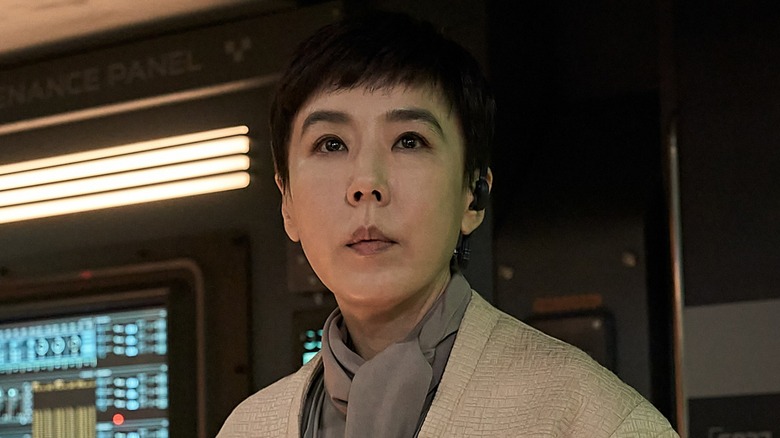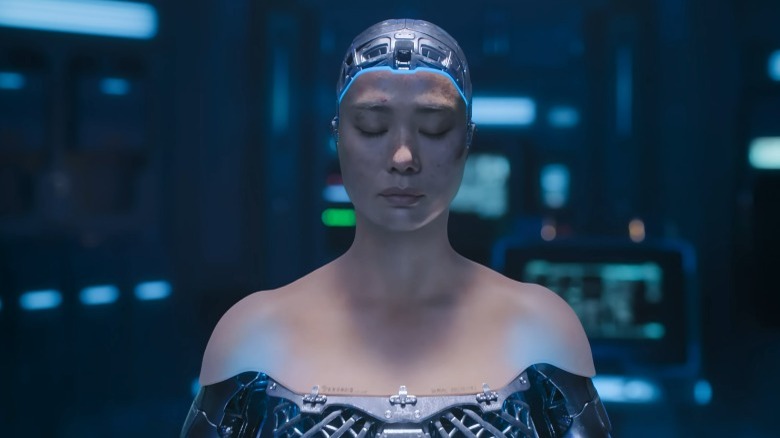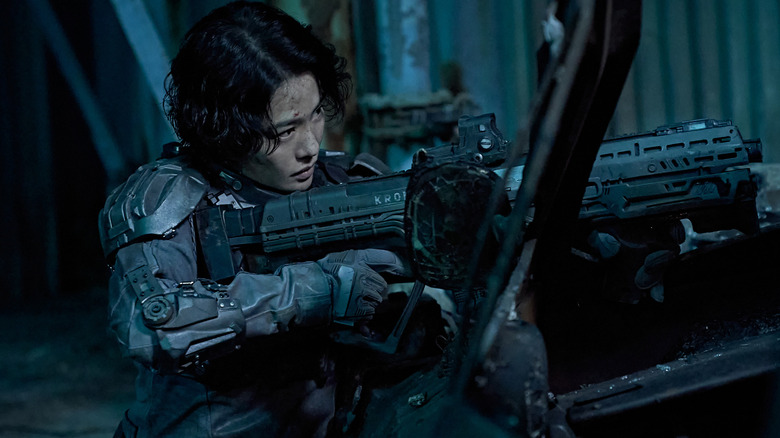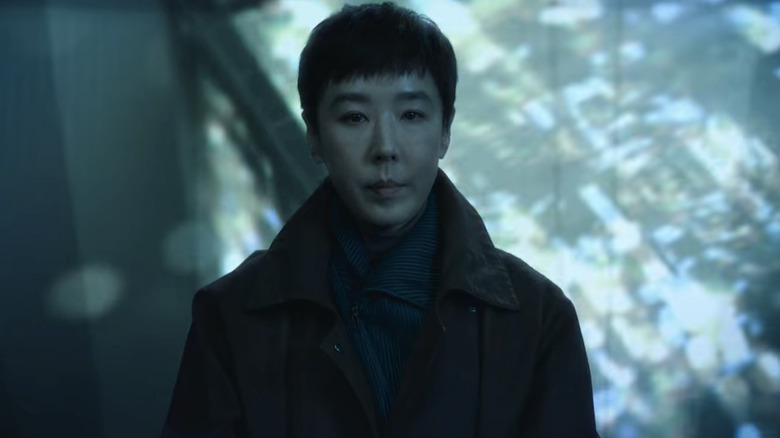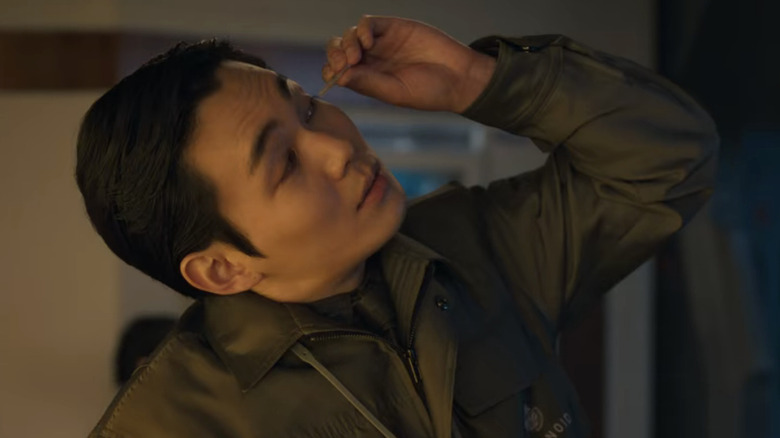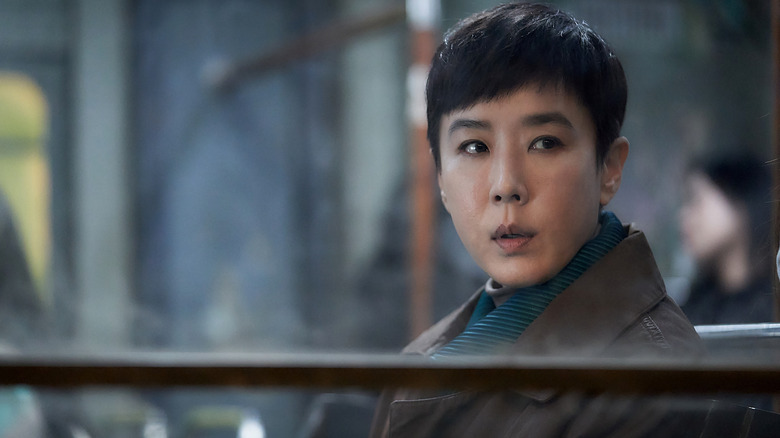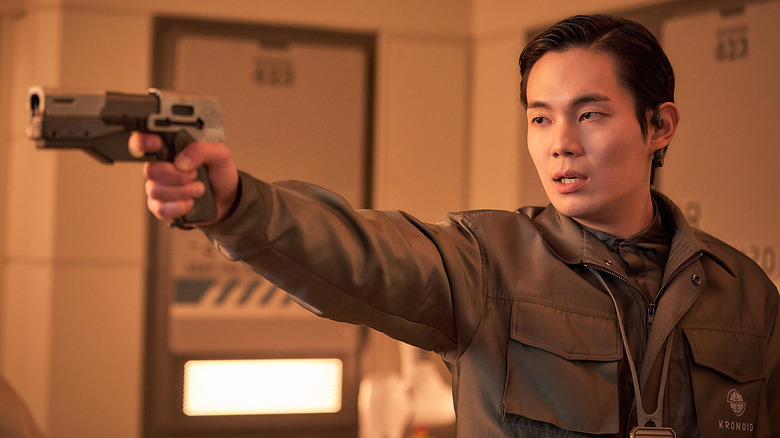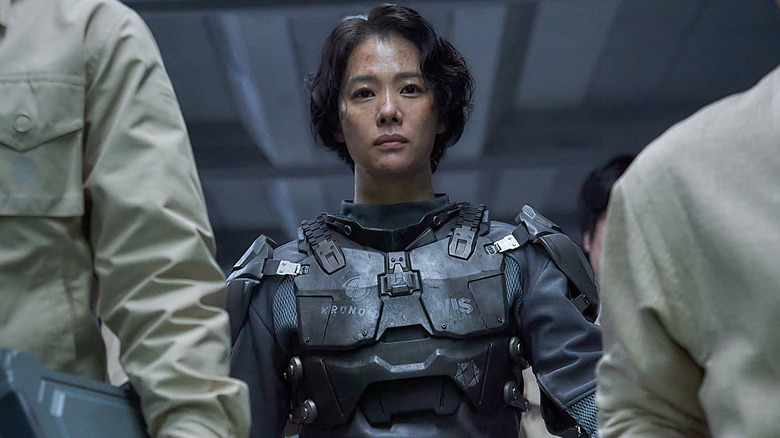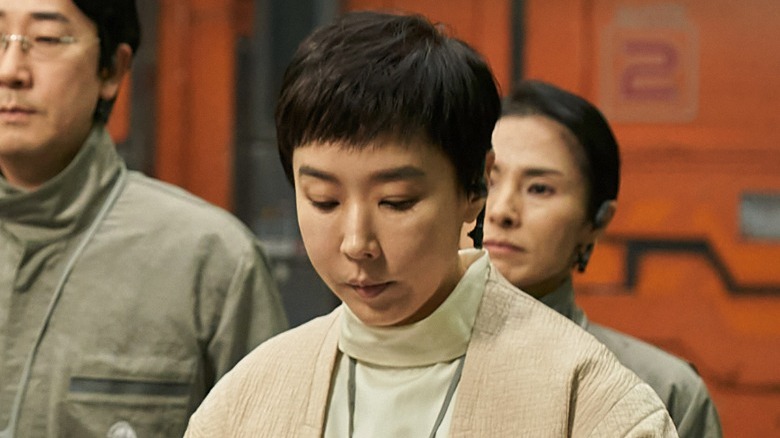Small Details You Missed In Netflix's Jung_E
Netflix's slate of original movies expands with "Jung_E," a sci-fi story from Yeon Sang-ho, the same filmmaker behind the critically-acclaimed "Train to Busan." Borrowing from influences like "Blade Runner," "Altered Carbon," and "Neuromancer," this Korean movie explores the process of consciousness replication and the myriad of moral and ethical dilemmas that the process inevitably creates.
The titular character, an android known as Jung_E (Kim Hyun-joo), is a robot with the mind and memories of a real human woman, Captain Yun Jung-yi. More accurately, as we learn by the end of "Jung_E," she's actually been many different androids as her mind has been being uploaded time and again into different bodies. As you'd expect, that leaves viewers with a complicated series of plot points and character beats to consider — including the literal beatings her robot bodies endure over and over.
In short, this isn't a straightforward story. Like any mind-warping sci-fi film with its sights set on existentialist nightmares, "Jung_E" is full of small details to pore over, parallels to draw, and philosophical questions to consider — alongside a healthy heaping of robot bears, pleasure bots, and parkour. Turn the latest upload of your consciousness to the screen as we reveal the small details you missed in Netflix's "Jung_E."
Who is the Adrian Republic?
The backdrop to "Jung_E" is explained in the movie's opening crawl — and repeated almost exactly 12 minutes later in a slideshow. When climate change becomes unbearable for the world's elite, they flee the planet and establish a series of space cities, three of which unite and decide to wage war on the remaining impoverished surface-dwellers. The aggressive space colonies rename themselves the Adrian Republic, a name that goes unexplained throughout all of "Jung_E."
To add even more mystery to the name, writer and director Yeon Sang-ho clearly chose the name in part because of its lack of connotations, unlike, for example, J. K. Rowling, who named her evil wizard a French variant of "flight of death," as explained exhaustively by Wizarding World. Yet there is some historical basis to the name, the small details of which may reveal a lot about the nation and its aims.
The name Adrian comes from the Roman names Adrianus and Hadrianus, and three famous Romans who bore one of those names were part of the ruling elite during their day. Adrianus of Tyre was a famous suck-up who became close with two different emperors. Hadrianus Augustus was an emperor, perhaps most famous for Hadrian's Wall, a boundary that spans England built to repel barbarian tribes. Lastly, there is Gaius Fabius Hadrianus, a Roman commander in charge of an outlying Roman province in Africa who was killed by a citizens' uprising. In all three cases, social parallels are evident.
Who is Kronoid?
The main story of "Jung_E"' takes place primarily in the laboratories of Kronoid, a mega-corporation that seems to have its hands in all areas of robotics, which are a major part of future life. Given their lack of oversight and tremendous power, especially in such a disorganized society, they may even serve as their own corporate nation. We know that they employ our main characters, scientist Seo-hyun (Kang Soo-yeon) and project leader Sang-Hoon (Ryu Kyung-Soo), in the hopes of turning Jung_E into the ultimate combat robot, but other than that, they're a mystery. However, the origin of their name and a few of their apparent goals tell us a ton.
Their name, Kronoid, seems to be a clear portmanteau of Kronos, the Greek Titan who commanded time itself, and android, human-like robots. Given Kronoid's focus on preventing death — i.e., controlling one's time on Earth — by transferring human minds into robot bodies, the portmanteau seems obvious.
On top of their on-the-nose name, Kronoid's ultimate goals seem to be geared towards extending their own time on top. From the ashes of old Earth, and seemingly Korea in particular, Kronoid rose up to become a new world power. Not only are they a major nation unto themselves, but they've also spent vast portions of their resources developing technology to keep their leadership alive — including copying their almighty chairman's mind into an android named Sang-Hoon.
The chairman
The Kronoid corporation in "Jung_E" may have its own mysterious past and ambitions, but their leader, known only as the chairman, is an equally important mystery himself — one partially cracked by something as simple as his title. Kronoid, whose power approaches (if not equals) that of a full-fledged sovereign nation, answers to the position of chairman, which is a perfectly average title for a simple company but an odd one for a country.
Notably, several Asian countries with more autocratic governments answer to a chairman, including North Korea at multiple times in its history, and China, which was famously led by Chairman Mao. In Kronoid's case, the title may imply that the corporation rose from within the Chinese or North Korean governments, operates similarly to them, or both. If the idea seems like a stretch, take a look at a scene around 47 minutes in, which takes place in Sang-Hoon's office. Nearly covering an entire wall is an Art Nouveau mural that depicts the chairman standing over a golden city, bathed in rays of sunshine — almost identical to the many propaganda posters commissioned by Chairman Mao during his reign.
However, there is another possible origin for the chairman title. The South Korean organization known as the Peaceful Unification Advisory Council, which hopes to unify North and South Korea, is also helmed by a chairman (though they use the term chairperson). That may hint at some hopeful news amidst the bleak future in which Kronoid exists.
Not the head!
The first scene in "Jung_E" features the titular android fighting waves of combat robots, some of which are humanoid and some that look like mechanical war bears, all armed with a variety of rifles and other weapons. Despite their numbers and apparent fearsomeness, Jung_E handles them all with ease — right up until she is killed. Except that she isn't. The whole fight is just one simulation in a long series of simulations, all of which are designed to test Jung_E's combat ability.
We see a few of these simulations, all of which end with Jung_E's death, but strangely, only after she's defeated tons of robots per attempt. They barely use their weapons, choosing to punch at her instead, and when they do fire at her, they only ever hit her in the leg or another extremity.
This detail is easily missed, but after some reflection, it becomes easier to understand. Jung_E's combat prowess, and everything valuable about her as a warrior, are kept in her brain. Sure, Kronoid wants to test Jung_E's skill again and again to improve it, but there's no improvement to be made — nor any data to be gathered from the test at all — if her brain is destroyed. This makes one small detail plain: Kronoid scientists programmed the simulated bots to deliberately avoid going for the coup de grâce when fighting Jung_E.
The ethics test
A small and easily forgettable scene occurs early on in "Jung_E" when Seo-hyun mentions to another employee that she's overdue for her regularly scheduled ethics test. Seo-hyun, of course, is the daughter of Captain Yun Jung-yi, whose mind was the basis for Jung_E, now all grown up and making a living by transferring her dead mother's consciousness from android to android while testing how well they murder other robots before they die. The test comes up again, also forgettably, and even once we see a portion of Seo-hyun's test, it seems like nothing remarkable. In reality, the ethics test is one of the film's most (literally) glaring homages.
The ethics test's moral and ethical riddles, many of them involving the treatment of animals, is a blatant and loving homage to the infamous Voight-Kampff test from the legendary "Blade Runner." In the original "Blade Runner," the Voight-Kampff test is used to distinguish androids from humans by detecting and comparing a series of automatic bodily functions in response to emotionally-provoking scenarios. These scenarios heavily focus on the treatment of animals, a holdover from the original Phillip K. Dick novel "Do Androids Dream of Electric Sheep?"
In "Jung_E," Kronoid's ethics test is evidently designed with the same methodology and for the same goal — or at least to keep the humans and androids on the same level.
The reason for the eye drops
There is one small detail in "Jung_E" that is truly blink-and-you-miss-it, especially because it happens through actual blinks. At several points in the first half of the film, project director Sang-Hoon pauses whatever eccentric rant he's begun to tilt his head back and squirt eye drops into his left eye. The behavior is never directly explained by the film, but during the midpoint revelation that Sang-Hoon is an android, one small detail offers a major clue.
When the chairman pauses Sang-Hoon and the android stands frozen in his chambers, every part of his body is completely motionless except for his left eyelid. The lid spasms up and down in an inhuman way, evidently a malfunction in Sang-Hoon's robotics.
Poor Sang-Hoon, who doesn't discover that he's an android until much later, has been dealing with inexplicably fluttering eyelids and trying to treat them with normal eye drops. Had he known he was an android, he could have had the parts repaired or perhaps even swapped out the eye drops for some WD-40. Instead, the eye drops are just a sad reminder that Sang-Hoon is unaware of his true nature and occupies a defective body.
The yellow memory
Surprisingly, one of the biggest plot points in "Jung_E" is actually left unspoken and only revealed by paying attention to a few small details.
The point in question is the scene in which Sang-Hoon finally finds the breakthrough he's been seeking, the precise type of brain activity that transforms the latest Jung_E model into the most effective warrior possible. A part of her brain begins firing rapidly upon being injured, somehow pushing her skill and determination to the max. Sang-Hoon then orders that brain activity be colored yellow when visualized to set it apart from previous, less effective activity, which had been colored red and green. The yellow activity is never explained in dialogue, so if you just put "Jung_E" on in the background, you'll likely never realize what it is.
To give herself some closure about her mother and their relationship, Seo-hyun sneaks into the lab after hours and activates the latest Jung_E model to talk to it — after all, Jung_E is a copy of her late mother's brain. When questioned, all Jung_E can think about is her daughter and her welfare, revealing that her motivation for kicking as much robot butt as possible is solely so she can survive and return home to her daughter. As she admits this and recalls her little girl, her brain lights up with activity — yellow activity.
Yeon Sang-ho is addicted to trains
"Jung_E" is written and directed by Yeon Sang-ho, most famous for the absolutely stellar zombie movie "Train to Busan" and related projects like "Seoul Station." If you've seen those films, you know how heavily they employ trains as set pieces and plot devices. Even if you haven't seen them, you could probably still guess from the names. Even though "Jung_E" is a departure from those movies in terms of genre, tone, and style, it still places multiple scenes on trains, including the dramatic final showdown, begging the question — what is up with Yeon and trains?
In "Train to Busan," the vehicle is a high-concept setting and narrative device, as well as a part of the movie's allegory on societal ills, so the train makes obvious sense. The world of "Jung_E," however, exists in the future, one far enough that massive, city-size space colonies exist, so the heavy reliance on trains is impossible to ignore.
Yeon chooses to show Seo-hyun's inner turmoil by having her stare out a train window in the rain, places important conversations between Seo-hyun and Sang-Hoon on commuter trains, and even sets the standoff between Sang-Hoon, Seo-hyun, and Jung_E on a train. There is no in-universe explanation, so we have to assume Yeon is just really, really into trains.
He can't control his emotions, either!
When Seo-hyun and Sang-Hoon visit Kronoid's stately headquarters, their first and only interaction with another Kronoid employee is baffling and unexplained. Unless, that is, you connect the dots on your own. As they stroll through an atrium hallway, an employee spots Sang-Hoon and bursts out laughing. When she calms down, she delivers some bad news to Sang-Hoon, who visibly and loudly flips out. Seeing this, the employee laughs again and cryptically exclaims, "It's so funny. You can't hide your feelings, either!" At this point, neither Sang-Hoon, Seo-hyun, nor even the audience understands the remark — not until the eventual reveal that Sang-Hoon is an android with the mind of a young chairman.
When we finally meet the chairman, it is obvious how eccentric he is. He never seems to respond to anything quite right, cracking jokes at odd moments and delivering heartbreaking news like it is nothing. It makes sense that Sang-Hoon and his chairman's brain would be similarly emotive, and so the Kronoid employee, who is evidently aware that Sang-Hoon is an android, laughs because she sees the clear mirror between the man she knows and his machine duplicate.
Jung, Jung, or Jung?
The title for "Jung_E" is striking, and its meaning may exist in multiple layers. On the one hand, Jung obviously derives from Yun Jung-yi, the name of the famous warrior whose brain is used to operate the Jung_E androids. As a given name, Jung is very common, both by itself and as either half of a two-syllable name, like Jung-yi. Likewise, the meaning of the name varies wildly depending on the character used to write it. Assuming that Yeon meant anything special by choosing Jung as a Korean given name would be a mistake, but it's the non-Korean Jung — the Swiss Jung, in fact — in which a ton of extra meaning can be found.
Carl Jung is one of the most prominent psychologists in history. Among many other major contributions to the field, Jung pioneered the concept of individuation, the process by which someone becomes distinctly themselves. In other words, Jung studied what made people uniform and what made them unique, which is the overarching theme of all of "Jung_E" — not to mention a huge portion of great sci-fi movies in general. The Jung_E robot's entire existence — and importantly, her multiple existences — is a test of what makes us all the same and what makes us unique. In other words, the manner of our individuation.
The final role for Kang Soo-yeon
One of the most important details you might have missed in "Jung_E" occurs behind the scenes and sadly involves the death of its star. The movie's main character, Seo-hyun, is played by legendary Korean actress Kang Soo-yeon, whose long career was so influential and celebrated that she was often hailed as Korea's "first world star" (via Independent). She earned dozens of awards in Korea and East Asia in general for her consistently exceptional acting and even took best actress at the 44th Venice Film Festival for her role in "The Surrogate Woman" — making Kang the first Korean actress to ever do so.
Sadly, Kang's final role was in "Jung_E." The actress passed away in May of 2022 from natural causes, mere months after filming for the movie finished. Because "Jung_E" didn't release until January of 2023, Kang was never able to see her final performance. For her exceptional contributions to Korean culture, the country's government posthumously awarded her the Eungwan Order of Cultural Merit, which Korea.net describes as "the country's second-highest government honor for culture."
Some of the movie's more contemplative, melancholy scenes, especially those in which Seo-hyun ruminates on the concept of death, hit harder knowing that they were some of the final scenes shot by Kang before her tragic passing.
